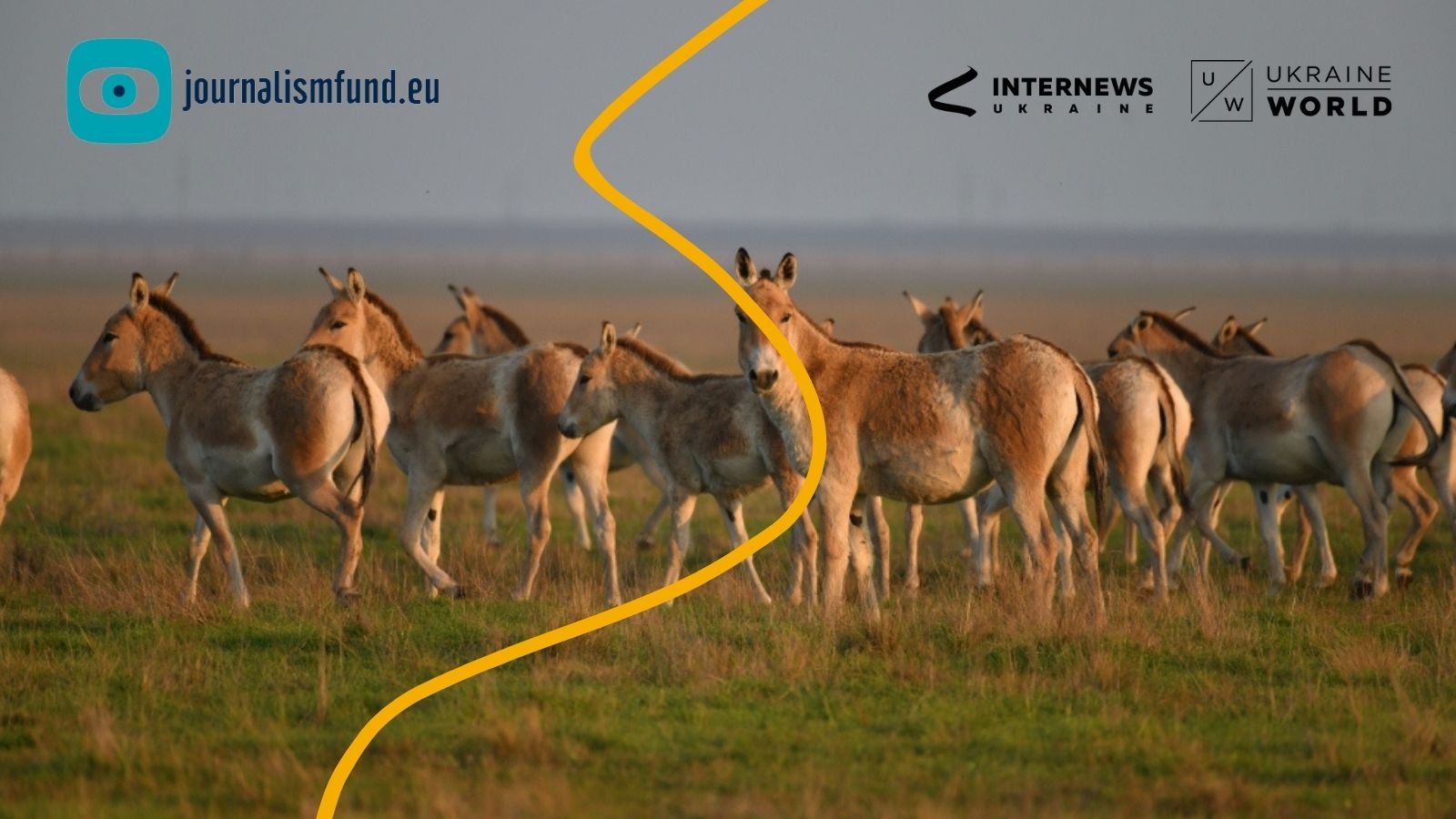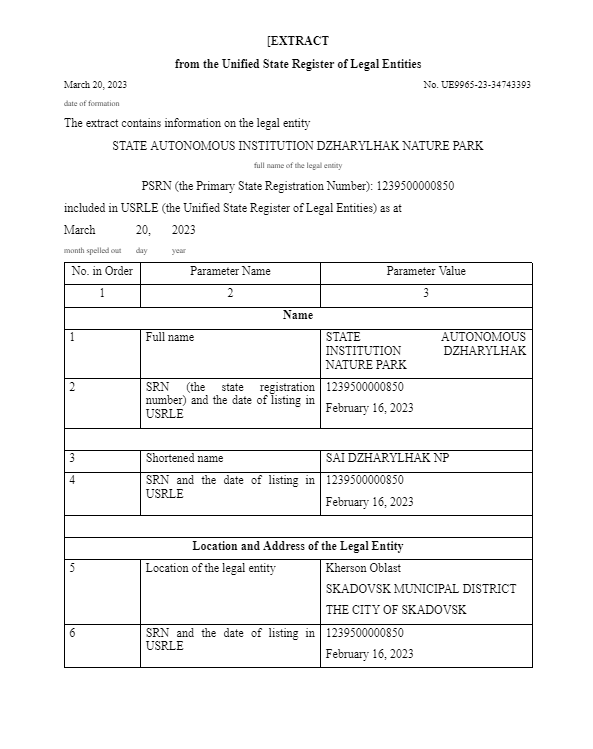
23 young ostriches died there. As it was impossible to communicate with the Ukrainian veterinary services, samples from the animals had to be sent to the Chaplynka Hospital for Veterinary Medicine, in inverted commas, operating under the Russian flag. Its so-called experts further transferred these samples to a Crimean laboratory that gave its verdict: avian flu.
Sources of the Center for Journalistic Investigations inside the town of Askania-Nova in Kakhovka District claim that the birds may have died from a completely different cause. However, it is completely impossible to establish what actually happened because of the occupation.
On February 23, the occupation authorities declared a strict quarantine of Askania-Nova and a 10-kilometer radius following the alleged avian flu outbreak. Despite this, the occupiers themselves have never intended to observe the restrictions in question.
 Volodymyr Saldo, the gauleiter of occupied Kherson Oblast, Sergey Kiriyenko, the First Deputy Chief of the Russia’s Presidential Administration, and Dmytro Meshcheryakov, the newly-proclaimed “director” of the Askania-Nova Nature Reserve ( fourth on the left). March 20, 2023. Image: Telegram channel of the occupation authorities.
Volodymyr Saldo, the gauleiter of occupied Kherson Oblast, Sergey Kiriyenko, the First Deputy Chief of the Russia’s Presidential Administration, and Dmytro Meshcheryakov, the newly-proclaimed “director” of the Askania-Nova Nature Reserve ( fourth on the left). March 20, 2023. Image: Telegram channel of the occupation authorities.
On March 20, it became obvious that the so-called quarantine of the village and its surroundings was entirely a sham when high-profile guests arrived by helicopter, including the Gauleiter of occupied Kherson Oblast Volodymyr Saldo and the First Deputy Chief of the Russian Presidential Administration Sergey Kiriyenko. An unknown man rushed to meet them, introducing himself as the director of the biosphere nature reserve.
It turned out that the Russians had created a clone of this scientific institution in their State Register and that had appointed this man, Dmytro Meshcheryakov, as its director via an order from the so-called Ministry of Natural Resources and Ecology of Kherson Oblast as early as February 28, 2023.
The guests calmly walked about the nature reserve, as if no quarantine had been declared there. Russian troops also felt at ease being stationed there. The occupation authorities imposed no quarantine measures, and the newly-proclaimed "director" even declared that he was going to develop tourism.
According to some residents of Askania-Nova who requested anonymity, "it seemed that Meshcheryakov was not even aware that Askania-Nova is an internationally significant nature protection and research institution, and not an entertainment venue. Our nature reserve begins with the steppe and ends with the steppe. Despite multiple problems, its employees continue taking care of thousands of hectares of protected territory. Of course, guided tours were given here before the occupation, but without any harm to the natural environment. Therefore, only people who are very far from all this can seriously talk about tourism here."
On March 24, the representatives of the nature reserve itself made a similar announcement on their Facebook page. "Because the biosphere nature reserve is under the control of the occupying authorities' administration, the preservation of nature conservation and the scientific research institution cannot be further ensured by the Ukrainian administration and is under immediate threat," their post stated.
 The Askania-Nova Biosphere Nature Reserve. Image: facebook.com/AskaniaNovaZapovednik.
The Askania-Nova Biosphere Nature Reserve. Image: facebook.com/AskaniaNovaZapovednik.
According to Oleksii Vasyliuk, the chairman and a co-founder of the Ukrainian Nature Protection Group, the protected steppes of Askania-Nova have never been of particular interest to the occupiers. For them, it is nothing more than grass in endless fields, and their actions confirm this.
Since October 23, 2022, the Russians have placed military equipment on the territory of both the village and the nature reserve and announced the so-called nationalization of all state property on the captured territory.
Among the first things the invaders looted from the nature reserve were two cars, a tractor with a trailer, some research equipment, and firearms that belonged to the State Protection Service of the Nature Reserve. They also blocked access to part of the arboretum, began to drive their heavy equipment through the protected steppe areas, and to dig trenches there.
In 2022, the occupiers caused three fires on the territory of the Askania-Nova reserve, burning almost 1.4 thousand hectares. Military aircraft have been constantly flying over the protected area at low altitudes, causing wild animals to panic and even sometimes die.
 The Askania-Nova Biosphere Nature Reserve. Image: facebook.com/AskaniaNovaZapovednik.
The Askania-Nova Biosphere Nature Reserve. Image: facebook.com/AskaniaNovaZapovednik.
There are also fears that Russian occupiers have been preparing to take animals from the nature reserve.
For example, in early November 2022, before the liberation of Kherson, the invaders looted a small local zoo, and on December 17, they took animals from a mini-zoo located at the Young Naturalists' Station of the Kakhovka City Council on the left bank of Kherson Oblast, absconding with them to Crimea. Though this could never be compared with the scale of the great Askania-Nova reserve.
Oleksii Vasyliuk explains, "The nature reserve has about 1.5 thousand ungulates from all over the world kept in the wild. They have been adapting to the Ukrainian steppe climate for many generations. That's why they are not Asian, but Ukrainian antelopes, Przewalski's horses, zebras, and bison. Should something happen to them, it will be impossible to bring in new ones to replace them, and we will lose an example of acclimatization of a large number of animals for more than a hundred years.
In addition, the nature reserve is critically dependent on having electricity, because the local arboretum must be watered daily from artesian wells. If its watering stops, all the trees and bushes will die in the arid steppe climate, and the picturesque lakes will dry up. That is why it is very easy to harm this nature reserve."
The animals also require special diets. Nature reserve employees have stocked up on hay on their own, but this is expected to last them until this autumn at most.
Benefactors have always provided, and continue to provide, significant assistance to this and other nature reserves. However, even with this assistance, it is unlikely that all the nature reserve's facilities will manage to survive the Russian occupation, since the monthly salary fund in Askania-Nova alone is about UAH 2 million. That does not even include costs for maintenance of the territory, fuel, and necessary medications for the animals and plants.
 Oleksii Vasyliuk. Image: facebook.com/vasyliuk.oleksii.
Oleksii Vasyliuk. Image: facebook.com/vasyliuk.oleksii.
Oleksii Vasyliuk considers that the greatest threats to the nature reserve are yet to come. After all, liberating Askania-Nova would require liberating the whole south of Ukraine, and since it is located near the administrative border with Crimea, the nature reserve would be one of the last places to be freed.
"That's why we have already started setting up a fund for its restoration after the war, and everyone interested can join it. Unfortunately, the occupation is unlikely to end peacefully for Askania-Nova. Despite this, there is always some hope for the best," Oleksii Vasyliuk adds.
The nature reserve mentions in its appeal that they will be able to get charitable financial support for their work only after the left bank of Kherson Oblast is freed from the Russian occupation.
"However, there is an urgent need for financial support for the employees who have refused to cooperate with the occupation authorities and administration. We will direct all our efforts in the near future to help the employees who were forced to temporarily leave the institution. This help will be no less important, because the further restoration of the nature reserve after the liberation will be highly dependent on these people," the organization stated.
The Russian occupiers made clear how they treat Ukrainian nature reserves with the Kamyanska Sich National Nature Park established in 2019. Located in Beryslav District of Kherson Oblast, the park was fully liberated on November 11, 2022. It contains the remains of the only unflooded Cossack Kamyanska Sich with the grave of Kish otaman Kost Hordiyenko.
The park is a branch of the Khortytsya National Nature Reserve. Over 12 thousand hectares of steppe with a 50-kilometer coastline along the Kakhovka Reservoir and unique historical monuments were mined by the invaders before their retreat, and the area is being shelled every day with all sorts of weapons, making it impossible to fully assess the scale of the damage.
 Serhiy Skoryk. Image: facebook.com/NPPKamyanskaSich.
Serhiy Skoryk. Image: facebook.com/NPPKamyanskaSich.
Serhiy Skoryk, the director of the Kamyanska Sich National Nature Park, explains that "so far we have managed to survey up to 20% of the land and to calculate losses of more than UAH 100 million. At the same time, we have not even begun to count the damage to the fish populations that is particularly connected with a sharp decrease in the reservoir's water level. In some places, the shoreline has receded by 17 meters, and the water level has dropped by 3.18 meters, which has never been observed before during the entire existence of the Kakhovka Reservoir.
However, we still cannot make calculations on this territory because of constant shelling. Sometimes we get as many as 60 Russian shells fired at us from the left bank in one day. On March 19, there was a fire that we had to extinguish from the road for two and a half hours. If we had been able to get closer to the fire, we would have put it out much faster. Unfortunately, we couldn't, and the surrounding fields have not yet been surveyed and demined."
Skoryk says that about 1 thousand hectares of the park's lands have already,affecting many plants from the Red Book. And we still need to investigate how many trees the occupiers have destroyed while digging their dugouts and spilling diesel fuel. Not all sites have been explored yet after shelling, as it takes about one and a half hours to check each hole.
In just seven months of occupying the park, the Russians destroyed 633 Genista scythica plants, 402 Stipa asperella plants, 832 Stipa capillata, 2,384 Lessing feather grass plants, 456 Ukrainian feather grass plants, and many other rare wild plants. Moreover, the Russian troops looted the property of the national nature park, taking transport vehicles, a rubber boat, furniture, and items, along with destroying the park's offices.
 Demining continues in the Kamyanska Sich National Nature Park. Image: facebook.com/NPPKamyanskaSich.
Demining continues in the Kamyanska Sich National Nature Park. Image: facebook.com/NPPKamyanskaSich.
 Artillery shells found in the Kamyanska Sich National Nature Park. Image: facebook.com/NPPKamyanskaSich.
Artillery shells found in the Kamyanska Sich National Nature Park. Image: facebook.com/NPPKamyanskaSich.
 Russian artillery shells littering the territory of the Kamyanska Sich National Nature Park. Image: facebook.com/NPPKamyanskaSich.
Russian artillery shells littering the territory of the Kamyanska Sich National Nature Park. Image: facebook.com/NPPKamyanskaSich.
Ivan Moisiyenko, the head of the Department of Botany at Kherson State University and a member of the board of directors of the Ukrainian Nature Protection Group, says that he was "shocked by the view at Kamyanska Sich from the roadside.
I saw a huge amount of unexploded ordnance from different systems, trenches, fortifications, chopped trees, and burned steppe. If the rest of the park looks like that, then it's a real disaster. However, I still hope that the invaders limited their fortifications to along the roads and bridges, and not in the depths of the steppe, so perhaps the damage isn't that bad there. However, we can talk about this only after demining and surveying the park."
According to him, it is much more difficult to talk about the situation in nature reserves on the left bank of Kherson and Mykolaiv Oblasts, which are still under occupation. Huge areas of the Black Sea Biosphere Nature Reserve and the Oleshky Sands and the Lower Dnipro National Nature Parks have been burned by fires caused by fighting. In the spring of 2022, strong fires broke out, but the occupiers did not even allow to extinguish them.
 Ivan Moisiyenko. Image: facebook.com/NPPKamyanskaSich.
Ivan Moisiyenko. Image: facebook.com/NPPKamyanskaSich.
The Russians have also turned the Kinburn Spit into a zone of continuous fires. According to satellite image analysis, within just the first six months of the full-scale war, the employees of the Svyatoslav White Coast National Nature Park, which covers the area of the spit, estimated that 5.2 thousand hectares had burned.
According to some other estimates, the total damage reached up to 10 thousand hectares, representing about 30% of the Kinburn forests.
"We'll never see the spit which we observed in 2021 again, as it took us decades to plant various types of pine trees here. However, the worst thing is the destruction of many unique relic plants that cannot be restored," laments Pavlo Kholodnyak, the deputy director of the park.
 Burning reed beds across from Kherson on April 28, 2022. Image: Vgoru.org.
Burning reed beds across from Kherson on April 28, 2022. Image: Vgoru.org.
According to experts interviewed by the Center for Journalistic Investigations, the situation remains difficult for the staff of the national nature parks and nature reserves under occupation. The presence of Russian military forces has greatly restricted, their work. In addition, some officials have been cooperating with the occupiers.
Ivan Moisiyenko explains, “Dmytro Kirin, the deputy director of the Lower Dnipro National Nature Park, and Serhiy Suvorov, the deputy director of the Dzharylhak National Nature Park and the former head of the State Inspectorate in Kherson Oblast, appear to be collaborating. Both of them had been removed from their positions and fled to the temporarily occupied territory before the right bank of Kherson Oblast was liberated on November 11, 2022.
The Russians have begun to appoint their own directors in the occupied parks and nature reserves, but it is unlikely that they have been doing this to carry out environmental protection activities. At least, no one knows anything about this. Most employees of these institutions have never met the Russian appointees.”
 Sergei Suvorov, a collaborator. Image from social media.
Sergei Suvorov, a collaborator. Image from social media.
 Dmytro Kirin, a collaborator. Image from social media.
Dmytro Kirin, a collaborator. Image from social media.
The Azov-Syvash National Nature Park was among the first areas the Russians seized. After receiving a Russian passport, Yevhen Popovchuk was appointed the director of the park and headed it for quite a long time until 2020. He also was the head of an organization in Henichesk called the Chintrel Association of Hunters and Fishermen and a deputy on the Henichesk Сity Сouncil from the Opposition Platform – For Life party.
It was Yevheniy Popovchuk who helped Russian occupiers loot the presidential summer residence on Byriuchyi Island and turned the nature conservation area into a recreation zone for Russian troops and collaborators.
 Yevheniy Popovchuk, a collaborator. Image from video screenshot.
Yevheniy Popovchuk, a collaborator. Image from video screenshot.
The Dzharylhak National Nature Park located in Skadovsk District was put under the “leadership” of an unknown Sergei Stramnov listed as a citizen of Russia in the Russian Register of Legal Entities. It was also recorded in this register that the main activities of the so-called Dzharylhak Nature Park State Autonomous Institution, illegally created by the occupiers, were the hunting, trapping, and shooting of wild animals.
In addition, this enterprise was set to provide services including fishing, clay and salt mining, construction, passenger water transportation, tours, and restaurant services. The occupiers provided official permission for similar types of activities in other captured nature conservation institutions of Kherson Oblast, as well.



The Black Sea Biosphere Nature Reserve, which is the largest and one of the oldest in Ukraine, was placed under the nominal leadership of Ihor Zhdanyuk, a resident of the village of Hladkivka in Skadovsk Raion. Having collaborated with the occupiers from the very beginning, he was also assigned to be a deputy to Hennadiy Nedyalkov, the Gauleiter of Hola Prystan.
 Ihor Zhdanyuk, a collaborator. Image from social media
Ihor Zhdanyuk, a collaborator. Image from social media
According to Ivan Moisiyenko, the occupiers even kidnapped some employees of nature parks and reserves.
Serhiy Leibak, a 35-year-old employee of the Svyatoslav White Coast National Nature Park, has been in captivity the longest, remaining imprisoned for more than a year. He was kidnapped by Russian soldiers along with Anatoliy Izbash, his colleague from the park, back on March 19, 2022. It occurred on the Kinburn Spit between the villages of Vasylivka and Heroiske.
 Serhiy Leibak, born 1987. Image from social media.
Serhiy Leibak, born 1987. Image from social media.
 Anatoliy Izbash.
Anatoliy Izbash.
[MISSING!
ANATOLIY IZBASH
Age: 45 (born in 1977)
Height: 180 cm
Body type: average
Hair: blonde
Eye color: blue
Date and place of disappearance: March 19, 2022 at 1:20 pm on the Kinburn Spit in Mykolaiv Oblast
Circumstances of disappearance: left from home with his friend and drove in his Mitsubishi car towards the village of Heroiske through the forest, after which his further location is unknown]
“The impact of the Russian occupation on all parts of our nature reserve, and not only on them, has been enormous. Overall, this is the first time since the Second World War when we have observed such an overwhelming negative impact on nature. And we will have to overcome its consequences for a very long period of time,” Moisiyenko concluded.
The material was prepared as part of the competition “Environmental Chronicles of War: Record, Research, Tell Stories” implemented by the NGO “Internews-Ukraine” with the financial support of Journalismfund.eu.
